Hydrogeochemical Characteristic of Geothermal Water and Precursory Anomalies along the Xianshuihe Fault Zone, Southwestern China
Abstract
:1. Introduction
2. Geological Setting
3. Sampling and Methods
4. Results and Discussion
4.1. Recharge Sources of Hot Springs
4.2. Origin of Water-Soluble Ions in Hot Springs
4.2.1. Origin of Major Elements
4.2.2. Characteristics of Strontium Isotopes
4.3. Water–Rock Interaction of Hot Springs
4.3.1. The Water–Rock Reaction Equilibrium
4.3.2. Mineral Saturation States
4.3.3. Reservoir Temperature and Circulation Depth
4.4. Spatial Distribution of Hydrogeochemical Characteristics in XSHF
4.5. Correlation between Hydrogeochemical Changes and Earthquakes
Precursory and Post-Seismic Anomalies
4.6. Conceptual Model of Hot Springs in the XSHF
5. Conclusions
- (1)
- The hot spring water at XSHF is recharged by infiltrating precipitation at recharge elevations of 1.8 to 4.5 km.
- (2)
- The hydrochemical types of most hot springs were mainly controlled by aquifer lithology. The heat storage temperature range was inferred from an equation based on SiO2 and chemical geothermometers method as 8–124 °C. The circulation depths for springs were estimated to range from 0.1 to 6.9 km.
- (3)
- The spatial distribution of hydrogeochemical characteristics of hot springs in the XSHF indicates part of the hot springs in the Kangding (W21–W35) and the Daofu (W9–W15) segments which had the highest reservoir temperature and the most frequent strong earthquakes in the two segments.
- (4)
- The temporal variations of dissolved chemical concentrations (Na+, Cl− and SO42−) decreased obviously after the Wenchuan Ms8.0 earthquake, with abnormal value fluctuations between the Lushan Ms7.0 and Kangding Ms6.3 earthquake occurred and after the 30 July 2017 returned to normal levels. And the ion concentrations (Na+, Cl− and SO42−) in hot springs increased by 5% to 35% three months before 22 November 2014 Kangding Ms6.3 with the obvious precursor anomaly. These results indicate that synchronous isotopic changes, as well as changes in water chemistry between multiple hot springs, were important for earthquake forecasting and the study of the response of earthquake precursors.
Supplementary Materials
Author Contributions
Funding
Institutional Review Board Statement
Informed Consent Statement
Data Availability Statement
Conflicts of Interest
References
- Claesson, L.; Skelton, A.; Graham, C.; Dietl, C.; Morth, M.; Torssander, P.; Kockum, I. Hydrogeochemical changes before and after a major earthquake. Geology 2004, 32, 641–644. [Google Scholar] [CrossRef]
- Reddy, D.V.; Nagabhushanam, P. Groundwater electrical conductivity and soil radon gas monitoring for earthquake precursory studies in Koyna, India. Appl. Geochem. 2011, 26, 731–737. [Google Scholar] [CrossRef]
- Wasteby, N.; Skelton, A.; Tollefsen, E.; Andren, M.; Stockmann, G.; Liljedahl, L.C.; Sturkell, E.; Morth, M. Hydrochemical monitoring, petrological observation, and geochemical modeling of fault healing after an earthquake. J. Geophys. Res.-Solid Earth 2014, 119, 5727–5740. [Google Scholar] [CrossRef]
- Skelton, A.; Andren, M.; Kristmannsdottir, H.; Stockmann, G.; Morth, C.-M.; Sveinbjoernsdottir, A.; Jonsson, S.; Sturkell, E.; Gudorunardottir, H.R.; Hjartarson, H.; et al. Changes in groundwater chemistry before two consecutive earthquakes in Iceland. Nat. Geosci. 2014, 7, 752–756. [Google Scholar] [CrossRef] [Green Version]
- Zhao, Y.; Liu, Z.; Li, Y.; Hu, L.; Chen, Z.; Sun, F.; Lu, C. A case study of 10 years groundwater radon monitoring along the eastern margin of the Tibetan Plateau and in its adjacent regions: Implications for earthquake surveillance. Appl. Geochem. 2021, 131, 105014. [Google Scholar] [CrossRef]
- Favara, R.; Grassa, F.; Inguaggiato, S.; Valenza, M. Hydrogeochemistry and stable isotopes of thermal springs: Earthquake-related chemical changes along Belice Fault (Western Sicily). Appl. Geochem. 2001, 16, 1–17. [Google Scholar] [CrossRef]
- Igarashi, G.; Saeki, S.; Takahata, N.; Sumikawa, K.; Tasaka, S.; Sasaki, Y.; Takahashi, M.; Sano, Y. Ground-water radon anomaly before the kobe earthquake in Japan. Science 1995, 269, 60–61. [Google Scholar] [CrossRef]
- Sano, Y.; Takahata, N.; Igarashi, G.; Koizumi, N.; Sturchio, N.C. Helium degassing related to the Kobe earthquake. Chem. Geol. 1998, 150, 171–179. [Google Scholar] [CrossRef]
- Skelton, A.; Liljedahl-Claesson, L.; Wästeby, N.; Andrén, M.; Stockmann, G.; Sturkell, E.; Mörth, C.M.; Stefansson, A.; Tollefsen, E.; Siegmund, H.; et al. Hydrochemical Changes before and after Earthquakes Based on Long-Term Measurements of Multiple Parameters at Two Sites in Northern Iceland—A Review. J. Geophys. Res. Solid Earth 2019, 124, 2702–2720. [Google Scholar] [CrossRef]
- Martinelli, G.; Ciolini, R.; Facca, G.; Fazio, F.; Gherardi, F.; Heinicke, J.; Pierotti, L. Tectonic-Related Geochemical and Hydrological Anomalies in Italy during the Last Fifty Years. Minerals 2021, 11, 107. [Google Scholar] [CrossRef]
- Tsunogai, U.; Wakita, H. Precursory chemical changes in ground water: Kobe earthquake, Japan. Science 1995, 269, 61–63. [Google Scholar] [CrossRef] [PubMed]
- Hosono, T.; Yamada, C.; Manga, M.; Wang, C.Y.; Tanimizu, M. Stable isotopes show that earthquakes enhance permeability and release water from mountains. Nat. Commun. 2020, 11, 2776. [Google Scholar] [CrossRef] [PubMed]
- Zhou, X.; Wang, W.; Chen, Z.; Yi, L.; Liu, L.; Xie, C.; Cui, Y.; Du, J.; Cheng, J.; Yang, L. Hot Spring Gas Geochemistry in Western Sichuan Province, China After the Wenchuan Ms 8.0 Earthquake. Terr. Atmos. Ocean. Sci. 2015, 26, 361–373. [Google Scholar] [CrossRef] [Green Version]
- Papadimitriou, E.; Wen, X.; Karakostas, V.; Jin, X. Earthquake Triggering along the Xianshuihe Fault Zone of Western Sichuan, China. Pure Appl. Geophys. 2004, 161, 1683–1707. [Google Scholar] [CrossRef]
- Chen, Z.; Du, J.; Zhou, X.; Yi, L.; Liu, L.; Xie, C.; Cui, Y.; Li, Y. Hydrochemistry of the hot springs in western Sichuan province related to the Wenchuan MS 8.0 earthquake. Sci. World J. 2014, 2014, 901432. [Google Scholar] [CrossRef] [Green Version]
- Li, B.; Shi, Z.; Wang, G.; Liu, C. Earthquake-related hydrochemical changes in thermal springs in the Xianshuihe Fault zone, Western China. J. Hydrol. 2019, 579, 124–175. [Google Scholar] [CrossRef]
- Zhang, L.; Guo, L.; Zhou, X.; Yang, Y.; Shi, D.; Liu, Y. Temporal variations in stable isotopes and synchronous earthquake-related changes in hot springs. J. Hydrol. 2021, 599, 126–316. [Google Scholar] [CrossRef]
- Xu, L.; Rondenay, S.; van der Hilst, R.D. Structure of the crust beneath the southeastern Tibetan Plateau from teleseismic receiver functions. Phys. Earth Planet. Inter. 2007, 165, 176–193. [Google Scholar] [CrossRef]
- Zheng, G.; Wang, H.; Wright, T.J.; Lou, Y.; Zhang, R.; Zhang, W.; Shi, C.; Huang, J.; Wei, N. Crustal Deformation in the India-Eurasia Collision Zone From 25 Years of GPS Measurements. J. Geophys. Res. Solid Earth 2017, 122, 9290–9312. [Google Scholar] [CrossRef]
- Chen, Z.; Burchfiel, B.C.; Liu, Y.; King, R.W.; Royden, L.H.; Tang, W.; Wang, E.; Zhao, J.; Zhang, X. Global Positioning System measurements from eastern Tibet and their implications for India/Eurasia intercontinental deformation. J. Geophys. Res. Solid Earth 2000, 105, 16215–16227. [Google Scholar] [CrossRef]
- Tapponnier, P.; Peltzer, G.; Armijo, R. On the mechanics of the collision between India and Asia. Geol. Soc. Lond. Spec. Publ. 1986, 19, 113–157. [Google Scholar] [CrossRef]
- Xu, Z.; Li, H.; Tang, Z.; Qi, X.; Li, H.; Cai, Z. The transformation of the terrain structures of the Tibet Plateau through large-scale strike-slip faults. Acta Petrol. Sin. 2011, 27, 3157–3170. [Google Scholar]
- Xueze, W.; Allen, C.; Zhuoli, L.; Hong, Q.; Huawei, Z.; Weishi, H. Segmentation, geometric features, and their seismotectonic implications for the Holocene Xianshuihe fault zone. Acta Seismol. Sin. 1989, 11, 362–372. [Google Scholar]
- Liu, Z.; Yuan, D.; He, S.; Zhang, M.; Zhang, J. Geochemical features of the geothermal CO2-watercarbonate rock system and analysis on its CO2 sources. Sci. China Ser. D Earth Sci. 2000, 43, 569–576. [Google Scholar] [CrossRef]
- Zhang, J.; Li, W.; Tang, X.; Tian, J.; Wang, Y.; Guo, Q.; Pang, Z. Geothermal data analysis at the high-temperature hydrothermal area in Western Sichuan. Sci. China Earth Sci. 2017, 60, 1507–1521. [Google Scholar] [CrossRef]
- Liu, C.; Zheng, Y.; Ge, C.; Xiong, X.; Hsu, H. Rupture process of the M s7.0 Lushan earthquake, 2013. Sci. China Earth Sci. 2013, 56, 1187–1192. [Google Scholar] [CrossRef]
- Chen, Z.; Zhou, X.; Du, J.; Xie, C.; Liu, L.; Li, Y.; Yi, L.; Liu, H.; Cui, Y. Hydrochemical characteristics of hot spring waters in the Kangding district related to the Lushan MS = 7.0 earthquake in Sichuan, China. Nat. Hazards Earth Syst. Sci. 2015, 15, 1149–1156. [Google Scholar] [CrossRef] [Green Version]
- Baird, R.B.; Eaton, A.D.; Rice, E.W. Standard Methods for Examination of Water and Wastewater, 23rd ed.; American Public Health Association (APHA): Washington, DC, USA, 2017; American Water Works Association (AWWA): Camden, NJ, USA, 2017; Water Environment Federation (WEF): Washington, DC, USA, 2017. [Google Scholar]
- Zhang, Y.; Zhang, L.; Yang, C.; Fan, Z.; Guo, D. Determining Trace Elements in Rock Samples Containing Refractory Minerals by Pressurize-microwave Inductively Coupled Plasma Mass Spectrometry. Uranium Geol. 2018, 34, 105–111. [Google Scholar]
- Wang, P.; Song, X.; Han, D.; Zhang, Y.; Liu, X. A study of root water uptake of crops indicated by hydrogen and oxygen stable isotopes: A case in Shanxi Province, China. Agric. Water Manag. 2010, 97, 475–482. [Google Scholar] [CrossRef]
- Barbieri, M.; Franchini, S.; Barberio, M.D.; Billi, A.; Boschetti, T.; Giansante, L.; Gori, F.; Jonsson, S.; Petitta, M.; Skelton, A.; et al. Changes in groundwater trace element concentrations before seismic and volcanic activities in Iceland during 2010-2018. Sci. Total Environ. 2021, 793, 148635. [Google Scholar] [CrossRef]
- Pang, Z.; Kong, Y.; Li, J.; Tian, J. An Isotopic Geoindicator in the Hydrological Cycle. Procedia Earth Planet. Sci. 2017, 17, 534–537. [Google Scholar] [CrossRef]
- Kong, Y.; Wang, K.; Li, J.; Pang, Z. Stable Isotopes of Precipitation in China: A Consideration of Moisture Sources. Water 2019, 11, 1239. [Google Scholar] [CrossRef] [Green Version]
- Luo, J.; Pang, Z.; Kong, Y.; Wang, Y. Geothermal potential evaluation and development prioritization based on geochemistry of geothermal waters from Kangding area, western Sichuan, China. Environ. Earth Sci. 2017, 76. [Google Scholar] [CrossRef]
- Benavente, O.; Tassi, F.; Reich, M.; Aguilera, F.; Capecchiacci, F.; Gutiérrez, F.; Vaselli, O.; Rizzo, A. Chemical and isotopic features of cold and thermal fluids discharged in the Southern Volcanic Zone between 32.5°S and 36°S: Insights into the physical and chemical processes controlling fluid geochemistry in geothermal systems of Central Chile. Chem. Geol. 2016, 420, 97–113. [Google Scholar] [CrossRef]
- Clark, I.D.; Clark, I.D.; Clark, I.D. Environmental Isotopes in Hydrogeology: Boca; CRC Press/Lewis Publishers: Boca Raton, FL, USA, 1998; Volume 80, p. 532. [Google Scholar]
- Li, C.; Zhou, X.; Yan, Y.; Ouyang, S.; Liu, F. Hydrogeochemical Characteristics of Hot Springs and Their Short-Term Seismic Precursor Anomalies along the Xiaojiang Fault Zone, Southeast Tibet Plateau. Water 2021, 13, 2638. [Google Scholar] [CrossRef]
- Apollaro, C.; Vespasiano, G.; De Rosa, R.; Marini, L. Use of mean residence time and flowrate of thermal waters to evaluate the volume of reservoir water contributing to the natural discharge and the related geothermal reservoir volume. Application to Northern Thailand hot springs. Geothermics 2015, 58, 62–74. [Google Scholar] [CrossRef]
- Vespasiano, G.; Marini, L.; Muto, F.; Auque, L.F.; Cipriani, M.; De Rosa, R.; Critelli, S.; Gimeno, M.J.; Blasco, M.; Dotsika, E.; et al. Chemical, isotopic and geotectonic relations of the warm and cold waters of the Cotronei (Ponte Coniglio), Bruciarello and Repole thermal areas, (Calabria- Southern Italy). Geothermics 2021, 96, 102–228. [Google Scholar] [CrossRef]
- Tian, J.; Pang, Z.; Wang, Y.; Guo, Q. Fluid geochemistry of the Cuopu high temperature geothermal system in the eastern Himalayan syntaxis with implication on its genesis. Appl. Geochem. 2019, 110, 102–442. [Google Scholar] [CrossRef]
- Capo, R.C.; Stewart, B.W.; Chadwick, O.A. Strontium isotopes as tracers of ecosystem processes: Theory and methods. Geoderma 1998, 82, 197–225. [Google Scholar] [CrossRef]
- Palmer, M.R.; Edmond, J.M. Controls over the strontium isotope composition of river water. Geochim. Cosmochim. Acta 1992, 56, 2099–2111. [Google Scholar] [CrossRef]
- Wang, Y.; Chen, J.; Chen, L. Tracing Groundwater with Strontium Isotopic Compositions in the Hexi Corridor Basin, Northwestern China; Springer: Berlin/Heidelberg, Germany, 2009; pp. 184–187. [Google Scholar]
- Giggenbach, W.F. Geothermal solute equilibria. Derivation of Na-K-Mg-Ca geoindicators. Geochim. Cosmochim. Acta 1988, 52, 2749–2765. [Google Scholar] [CrossRef]
- Aiuppa, A.; Dongarra, G.; Capasso, G.; Allard, P. Trace elements in the thermal groundwaters of Vulcano Island (Sicily). J. Volcanol. Geotherm. Res. 2000, 98, 189–207. [Google Scholar] [CrossRef]
- Fournier, R.; Rowe, J. The deposition of silica in hot springs. Bull. Volcanol. 1966, 29, 585–587. [Google Scholar] [CrossRef]
- Fournier, R.; Potter, I. Revised and expanded silica (quartz) geothermometer. Bull. Geotherm. Resour. Counc. Davis Calif. U. S. 1982, 11, 55–70. [Google Scholar]
- Tonani, F. Some remarks on the application of geochemical techniques in geothermal exploration. In Advances in European Geothermal Research; Springer: Berlin/Heidelberg, Germany, 1980; pp. 428–443. [Google Scholar]
- Pang, Z.H.; Wang, J.Y.; Fan, Z.C. Calculation of reservoir temperature using a SiO2 mixing model, Zhangzhou geothermal-field, SE China. Chin. Sci. Bull. 1990, 35, 1360–1363. [Google Scholar]
- Tian, J.; Pang, Z.; Guo, Q.; Wang, Y.; Li, J.; Huang, T.; Kong, Y. Geochemistry of geothermal fluids with implications on the sources of water and heat recharge to the Rekeng high-temperature geothermal system in the Eastern Himalayan Syntax. Geothermics 2018, 74, 92–105. [Google Scholar] [CrossRef]
- Hosono, T.; Masaki, Y. Post-seismic hydrochemical changes in regional groundwater flow systems in response to the 2016 Mw 7.0 Kumamoto earthquake. J. Hydrol. 2020, 580, 124–340. [Google Scholar] [CrossRef]
- Wang, B.; Zhou, X.; Zhou, Y.; Yan, Y.; Li, Y.; Ouyang, S.; Liu, F.; Zhong, J. Hydrogeochemistry and Precursory Anomalies in Thermal Springs of Fujian (Southeastern China) Associated with Earthquakes in the Taiwan Strait. Water 2021, 13, 3523. [Google Scholar] [CrossRef]
- Hosono, T.; Yamada, C.; Shibata, T.; Tawara, Y.; Wang, C.Y.; Manga, M.; Rahman, A.T.M.S.; Shimada, J. Coseismic Groundwater Drawdown Along Crustal Ruptures During the 2016 M. w 7.0 Kumamoto Earthquake. Water Resour. Res. 2019, 55, 5891–5903. [Google Scholar] [CrossRef] [Green Version]
- Martinelli, G.; Facca, G.; Genzano, N.; Gherardi, F.; Lisi, M.; Pierotti, L.; Tramutoli, V. Earthquake-Related Signals in Central Italy Detected by Hydrogeochemical and Satellite Techniques. Front. Earth Sci. 2020, 8, 584–716. [Google Scholar] [CrossRef]
- Thomas, D. Geochemical precursors to seismic activity. Pure Appl. Geophys. PAGEOPH 1988, 126, 241–266. [Google Scholar] [CrossRef]
- Tokunaga, T. Modeling of earthquake-induced hydrological changes and possible permeability enhancement due to the 17 January 1995 Kobe Earthquake, Japan. J. Hydrol. 1999, 223, 221–229. [Google Scholar] [CrossRef]
- Cheng, J.; Liu, J.; Gan, W.; Yu, H.; Li, G. Characteristics of strong earthquake evolution around the eastern boundary faults of the Sichuan-Yunnan rhombic block. Sci. China Earth Sci. 2011, 54, 1716–1729. [Google Scholar] [CrossRef]
- Wang, M.; Shen, Z.K. Present-Day Crustal Deformation of Continental China Derived From GPS and Its Tectonic Implications. J. Geophys. Res. Solid Earth 2020, 125. [Google Scholar] [CrossRef] [Green Version]
- Ma, J. On whether earthquake precursors help for prediction do exist. Chin. Sci. Bull. 2016, 61, 409–414. [Google Scholar] [CrossRef] [Green Version]
- Zhou, X.; Yan, Y.; Fang, W.; Wang, W.; Shi, H.; Li, P. Short-Term Seismic Precursor Anomalies of Hydrogen Concentration in Luojishan Hot Spring Bubbling Gas, Eastern Tibetan Plateau. Front. Earth Sci. 2021, 8, 586279. [Google Scholar] [CrossRef]
- Paonita, A.; Caracausi, A.; Martelli, M.; Rizzo, A.L. Temporal variations of helium isotopes in volcanic gases quantify pre-eruptive refill and pressurization in magma reservoirs: The Mount Etna case. Geology 2016, 44, 499–502. [Google Scholar] [CrossRef]
- Sano, Y.; Takahata, N.; Kagoshima, T.; Shibata, T.; Onoue, T.; Zhao, D. Groundwater helium anomaly reflects strain change during the 2016 Kumamoto earthquake in Southwest Japan. Sci. Rep. 2016, 6, 37939. [Google Scholar] [CrossRef]
- Ai, Y.; Zhang, J.; Dong, M.; Wang, B.; Fang, G. Heat generation effects from shear friction along Xianshui river strike-slip fault in western Sichuan, China. Geothermics 2021, 89, 101936. [Google Scholar] [CrossRef]
- Claesson, L.; Skelton, A.; Graham, C.; MÖRth, C.M. The timescale and mechanisms of fault sealing and water-rock interaction after an earthquake. Geofluids 2007, 7, 427–440. [Google Scholar] [CrossRef]
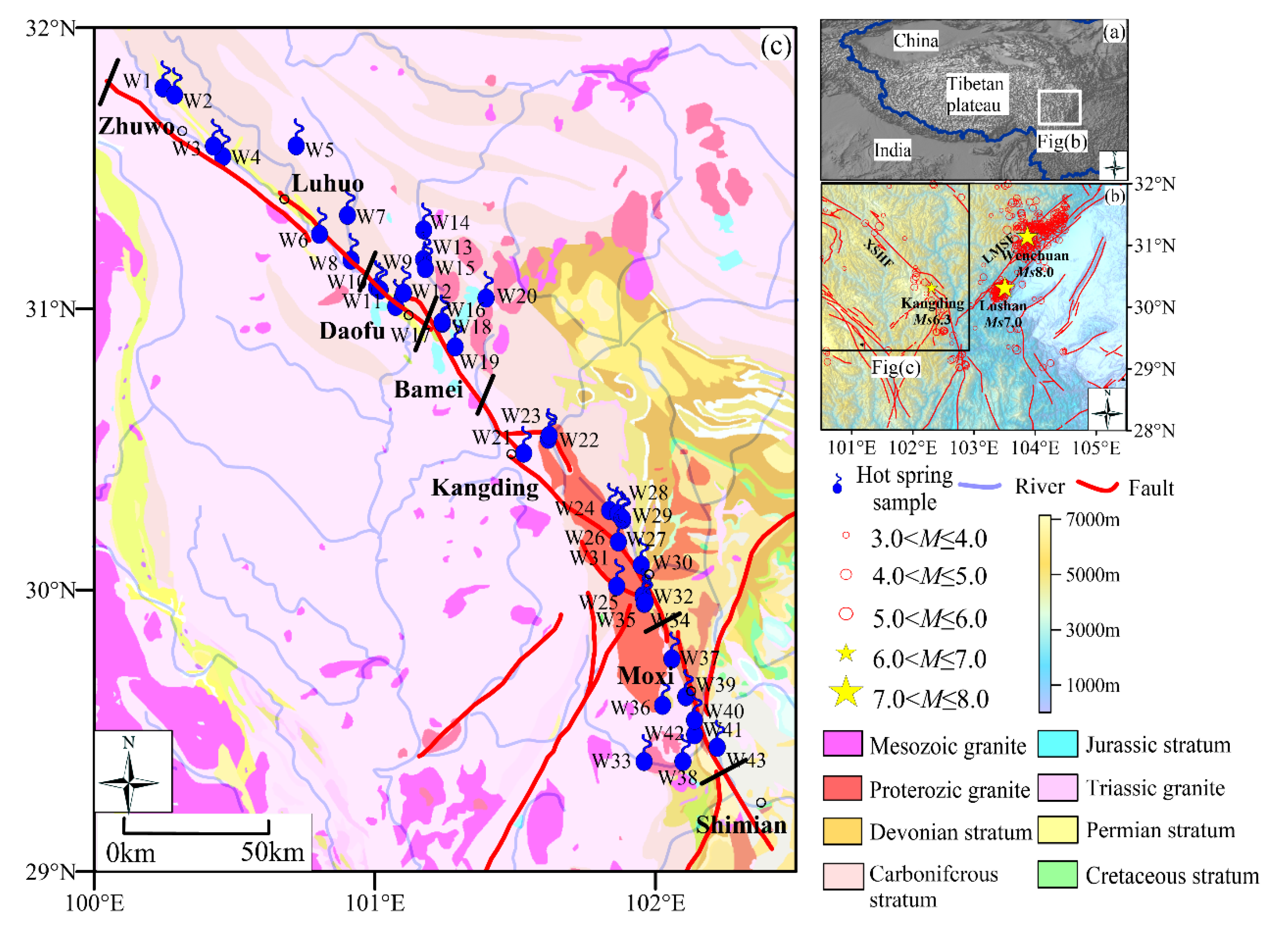



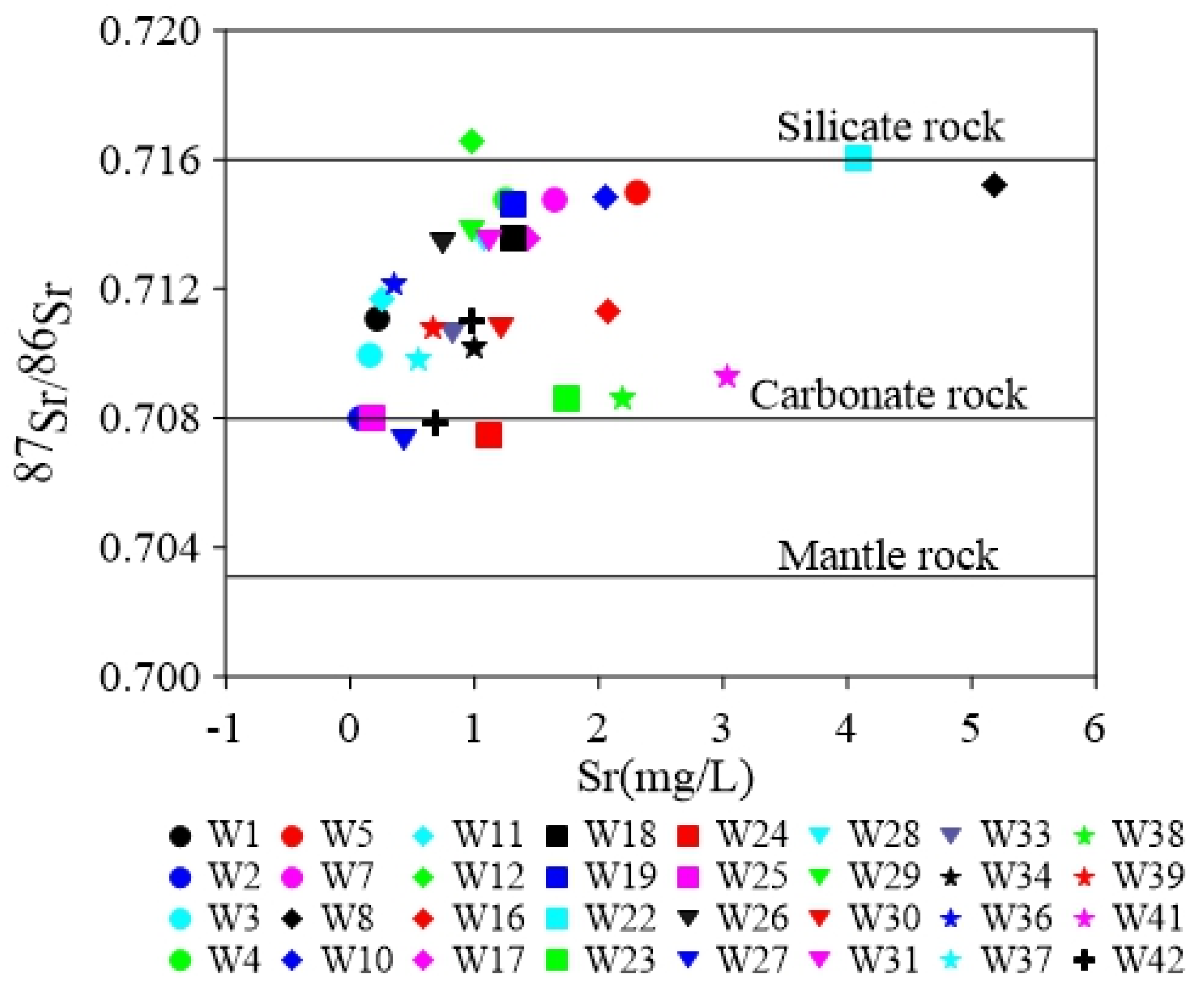

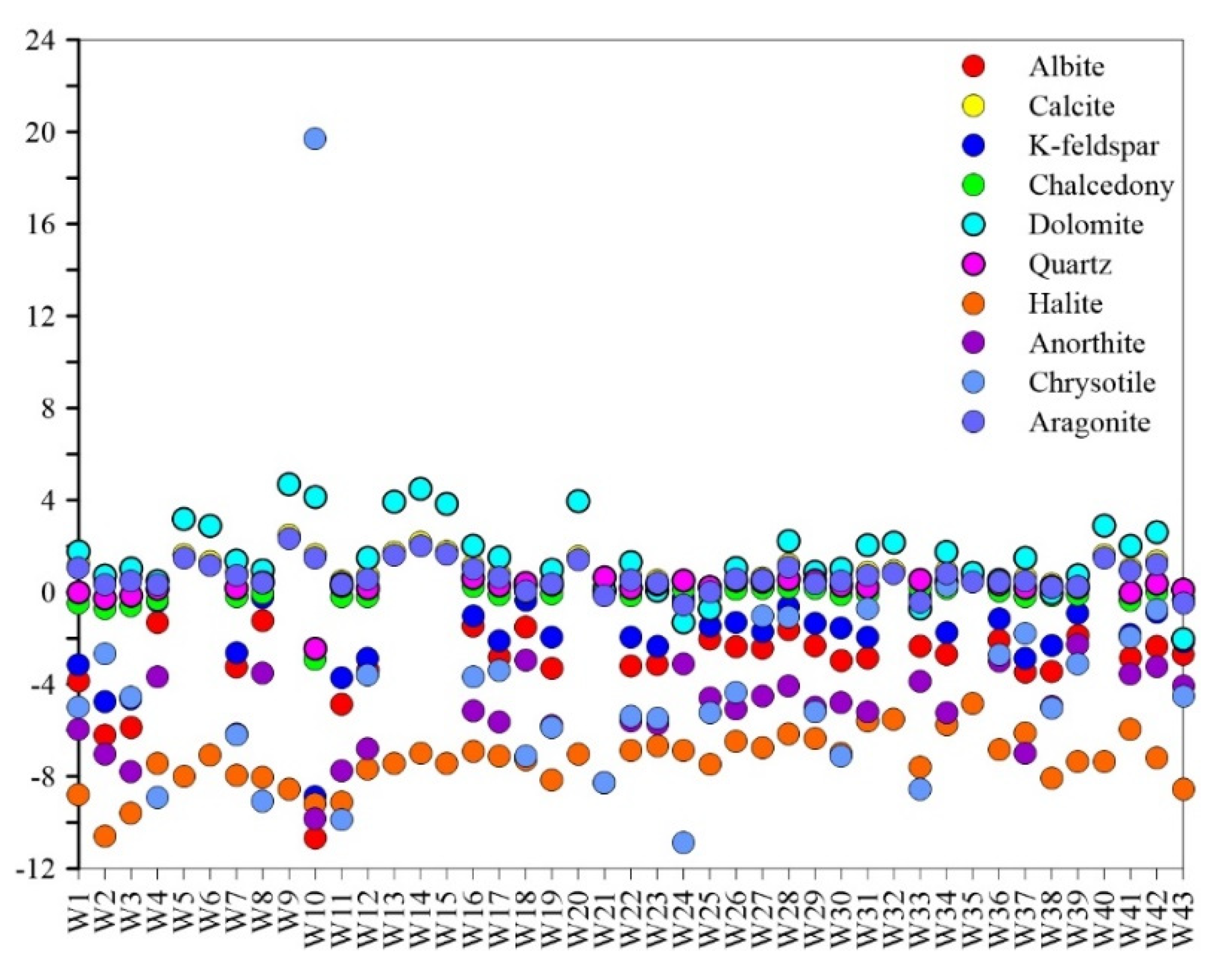

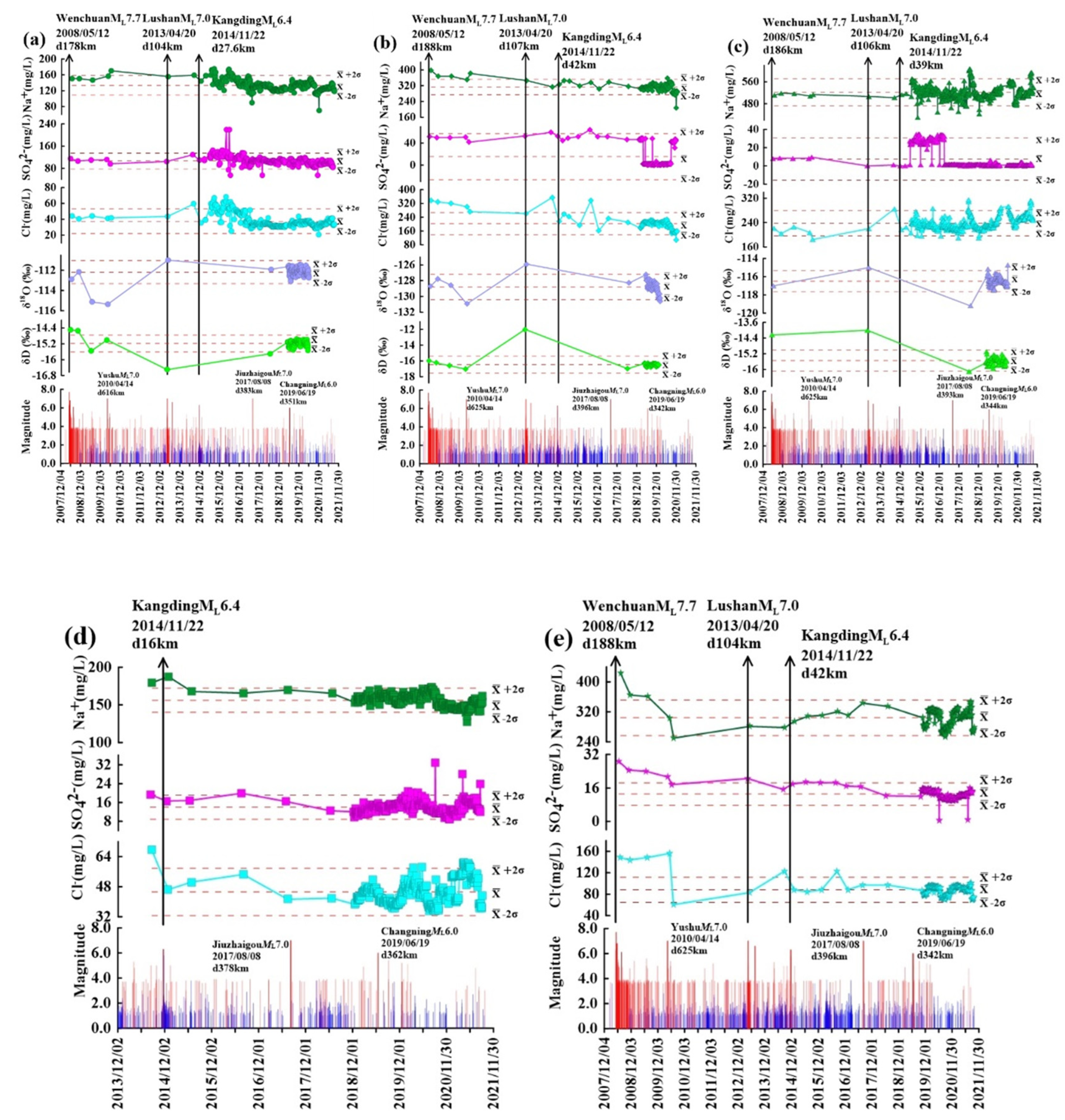
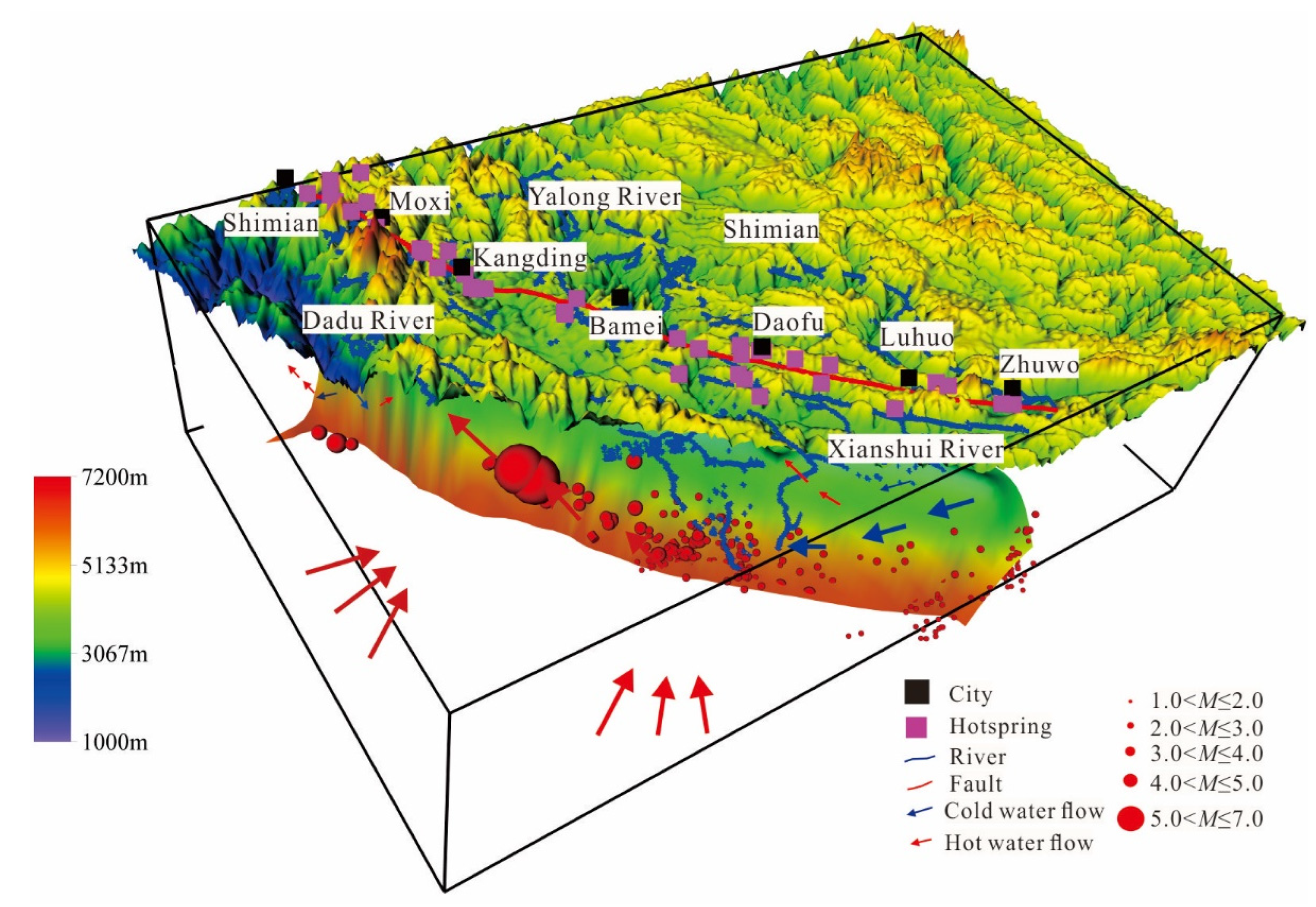
| No. | Site | Longitude | Latitude | Altitude | Structural Location |
|---|---|---|---|---|---|
| (°) | (°) | (km) | |||
| W1 | Niku | 100.25 | 31.79 | 3293 | Zhuwo and Luhuo segment |
| W2 | Kale | 100.29 | 31.76 | 3995 | |
| W3 | Goudi | 100.43 | 31.58 | 3441 | |
| W4 | Shawan | 100.46 | 31.54 | 3447 | |
| W5 | Ridu | 100.72 | 31.58 | 3352 | |
| W6 | Luhuoguyicun | 100.8 | 31.27 | 3102 | |
| W7 | Nilachatuo | 100.9 | 31.33 | 3511 | |
| W8 | Jinka | 100.92 | 31.17 | 3131 | |
| W9 | Benglong | 101.01 | 31.08 | 3007 | Daofu segment |
| W10 | Niri | 101.02 | 31.07 | ---- | |
| W11 | Wakamu | 101.08 | 31.01 | 3050 | |
| W12 | Xinjianggou | 101.1 | 31.06 | 3258 | |
| W13 | Qimei member1 | 101.17 | 31.18 | 3889 | |
| W14 | Jiazong | 101.18 | 31.28 | 3686 | |
| W15 | Qimei member2 | 101.18 | 31.14 | 3941 | |
| W16 | Loho Hot Springs ReWort | 101.24 | 30.95 | 3392 | Bamei segment |
| W17 | Longpugou member1 | 101.24 | 30.95 | 3392 | |
| W18 | Longpugou member2 | 101.24 | 30.95 | 3373 | |
| W19 | Canglonggou | 101.29 | 30.86 | 3540 | |
| W20 | Danba | 101.4 | 31.04 | 3665 | |
| W21 | Kama | 101.53 | 30.49 | 3622 | Kangdign segment |
| W22 | Bameihaoniu member1 | 101.62 | 30.54 | 3467 | |
| W23 | Bameihaoniu member2 | 101.62 | 30.55 | 3570 | |
| W24 | Yalashenshan | 101.84 | 30.28 | 3217 | |
| W25 | Zheduotang | 101.86 | 30.01 | 3245 | |
| W26 | Zhonggu | 101.87 | 30.27 | 3095 | |
| W27 | Mugecuo | 101.87 | 30.17 | 3565 | |
| W28 | Washangfang | 101.88 | 30.25 | 3066 | |
| W29 | Yala | 101.88 | 30.25 | 3027 | |
| W30 | Erdaoqiao | 101.95 | 30.09 | 3003 | |
| W31 | Longtougou | 101.96 | 29.98 | 2968 | |
| W32 | Kuaishuang | 101.96 | 29.97 | 2878 | |
| W34 | Guanding | 101.96 | 29.95 | 3027 | |
| W35 | Kangdingzk1 | 101.96 | 29.96 | 2978 | |
| W33 | Gongjiagou | 101.96 | 29.39 | 2492 | Moxi segment |
| W36 | Erhaoyingdi | 102.03 | 29.59 | 2672 | |
| W37 | Xinxingxiang | 102.06 | 29.75 | 2234 | |
| W38 | Caoke | 102.1 | 29.39 | 1954 | |
| W39 | Gonghe | 102.11 | 29.62 | 1601 | |
| W40 | Luding | 102.11 | 29.62 | 1601 | |
| W41 | Wandong | 102.14 | 29.54 | 1311 | |
| W42 | Tianwanhekou | 102.14 | 29.49 | 2089 | |
| W43 | Whimiandizhentai | 102.22 | 29.44 | 977 |
| NO. | SiO2 (mg/L) | Sr (μg/L) | 87Sr/86Sr (‰) |
|---|---|---|---|
| W1 | 3.6 | 224.00 | 0.711059 |
| W2 | 3.5 | 71.10 | 0.708004 |
| W3 | 4.6 | 164.00 | 0.709966 |
| W4 | — | 1259.00 | 0.714769 |
| W5 | 8.8 | 2313.00 | 0.715018 |
| W6 | — | 924.00 | — |
| W7 | — | 1639.00 | 0.714765 |
| W8 | 12.4 | 5189.00 | 0.715205 |
| W9 | — | 1773.00 | — |
| W10 | 4.6 | 2062.00 | 0.714804 |
| W11 | 7.6 | 255.00 | 0.711686 |
| W12 | — | 981.00 | 0.716574 |
| W13 | — | 584.90 | — |
| W14 | — | 660.20 | — |
| W15 | — | 386.60 | — |
| W16 | — | 2075.00 | 0.711284 |
| W17 | 20.5 | 1434.00 | 0.713561 |
| W18 | 25.3 | 1302.00 | 0.713566 |
| W19 | 21.6 | 1306.00 | 0.714624 |
| W20 | — | 15.99 | — |
| W21 | 34.9 | 568.00 | 0.712532 |
| W22 | 23.9 | 4092.00 | 0.716061 |
| W23 | 54.8 | 1739.00 | 0.708563 |
| W24 | 43.4 | 1124.00 | 0.707432 |
| W25 | — | 182.00 | 0.707982 |
| W26 | 46.0 | 747.00 | 0.713419 |
| W27 | 76.3 | 436.00 | 0.707290 |
| W28 | 59.7 | 1073.00 | 0.713503 |
| W29 | 51.4 | 988.00 | 0.713756 |
| W30 | 19.8 | 1208.00 | 0.710813 |
| W31 | 41.4 | 1116.00 | 0.713452 |
| W32 | — | 224.00 | — |
| W34 | 79.9 | 1001.00 | 0.710176 |
| W35 | — | — | — |
| W33 | 36.1 | 818.00 | 0.710616 |
| W36 | 60.5 | 351.00 | 0.712110 |
| W37 | — | 549.00 | 0.709801 |
| W38 | 19.5 | 2184.00 | 0.708619 |
| W39 | 20.9 | 663.00 | 0.710776 |
| W40 | 27.3 | 833.00 | — |
| W41 | 20.1 | 3024.00 | 0.709245 |
| W42 | 45.0 | 978.00 | 0.711021 |
| W43 | 11.9 | — | — |
| NO. | SiO2 (°C) | K-Mg (°C) | Na-K (°C) | Temperature (°C) | Reservoir Temperature (°C) | Circulation Depth (km) | Structural Location |
|---|---|---|---|---|---|---|---|
| W1 | 9.5 | 48.7 | 199.8 | 10.0 | 9.5 | 0.2 | Zhuwo and Luhuo segment |
| W2 | 8.3 | 89.3 | 257.2 | 25.0 | 8.3 | 0.1 | |
| W3 | 16.1 | 65.7 | 234.0 | 26.2 | 16.1 | 0.5 | |
| W4 | — | 23.5 | 141.5 | 11.0 | 82.5 | 3.7 | |
| W5 | 35.3 | 20.6 | 195.3 | 19.7 | 35.3 | 1.4 | |
| W6 | — | 20.9 | 133.1 | 37.5 | 77.0 | 3.5 | |
| W7 | 53.4 | 21.9 | 150.1 | 39.9 | 75.2 | 3.4 | |
| W8 | 46.4 | 40.1 | 165.6 | 16.5 | 46.4 | 2.0 | |
| W9 | — | 54.9 | 230.9 | 14.3 | 142.9 | 6.7 | Daofu segment |
| W10 | 15.9 | 65.5 | 303.2 | 15.3 | 15.9 | 0.5 | |
| W11 | 30.5 | 80.4 | 200.8 | 12.6 | 30.5 | 1.2 | |
| W12 | — | 15.1 | 152.0 | 52.0 | 83.5 | 3.8 | |
| W13 | — | 20.4 | 194.3 | 51.5 | 107.4 | 5.0 | |
| W14 | — | 16.5 | 224.1 | 35.4 | 120.3 | 5.6 | |
| W15 | — | 17.8 | 205.5 | 53.0 | 111.7 | 5.2 | |
| W16 | — | 14.6 | 131.0 | 42.8 | 72.8 | 3.3 | Bamei segment |
| W17 | 64.4 | 30.4 | 160.9 | 41.0 | 64.4 | 2.8 | |
| W18 | 72.5 | 20.9 | 163.1 | 39.6 | 72.5 | 3.2 | |
| W19 | 66.4 | 23.0 | 264.3 | 39.6 | 66.4 | 2.9 | |
| W20 | — | 17.8 | 206.8 | 73.0 | 112.3 | 5.2 | |
| W21 | 85.8 | 21.5 | 288.2 | 32.0 | 85.8 | 3.9 | Kangding segment |
| W22 | 70.3 | −1.6 | 275.8 | 55.0 | 70.3 | 3.1 | |
| W23 | 106.1 | −6.0 | 216.5 | 72.0 | 106.1 | 4.9 | |
| W24 | 95.3 | 9.7 | 211.7 | 39.0 | 95.3 | 4.4 | |
| W25 | — | 9.4 | 119.1 | 35.0 | 64.3 | 2.8 | |
| W26 | 98.0 | 4.9 | 237.2 | 52.0 | 98.0 | 4.5 | |
| W27 | 122.6 | 0.7 | 217.0 | 74.7 | 122.6 | 5.7 | |
| W28 | 110.3 | 4.2 | 228.1 | 56.0 | 110.3 | 5.1 | |
| W29 | 103.1 | 8.6 | 229.7 | 55.4 | 103.1 | 4.7 | |
| W30 | 63.1 | 18.9 | 275.5 | 40.5 | 63.1 | 2.8 | |
| W31 | 93.2 | 3.2 | 237.0 | 72.0 | 93.2 | 4.3 | |
| W32 | — | −6.0 | 240.7 | 72.0 | 117.4 | 5.4 | |
| W34 | 125.0 | 1.4 | 250.7 | 75.8 | 125.0 | 5.8 | |
| W35 | — | −31.3 | 256.7 | 82.0 | 112.7 | 5.2 | |
| W33 | 87.2 | 17.8 | 284.9 | 40.8 | 87.2 | 4.0 | Moxi segment |
| W36 | 110.9 | 4.1 | 253.1 | 75.3 | 110.9 | 5.1 | |
| W37 | — | 22.3 | 152.4 | 47.0 | 87.3 | 4.0 | |
| W38 | 62.5 | 28.5 | 236.1 | 45.7 | 62.5 | 2.8 | |
| W39 | 65.1 | 29.4 | 233.3 | 57.0 | 65.1 | 2.9 | |
| W40 | 75.6 | 25.9 | 222.5 | 57.2 | 75.6 | 3.4 | |
| W41 | 63.6 | 8.3 | 250.6 | 65.3 | 63.6 | 2.8 | |
| W42 | 97.0 | 22.4 | 307.7 | 50.6 | 97.0 | 4.4 | |
| W43 | 45.0 | 32.5 | 156.1 | 35.0 | 45.0 | 1.9 |
| Monitoring Sites | Changes | 2008 Wenchuan Ms8.0 | 2013 Lushang Ms7.0 | 2014 Kangding Ms6.3 | ||
|---|---|---|---|---|---|---|
| Post-Seismic Anomalies | Post-Seismic Anomalies | Precursory Anomaly | Postseiscxxx Anomalies | |||
| W25 | Na+ | (%) | ↑6.0 | ↑5.2 | ↑8.0 | ↑7.6 |
| Cl− | ↑21.4 | ↑2.9 | ↓7.8 | ↑15.8 | ||
| Epicenter distance | (km) | 190 | 114 | 33 | ||
| W27 | Na+ | (%) | — | — | ↑5.4 | ↑10.0 |
| Cl− | — | — | ↑28.2 | ↑44.8 | ||
| SO42− | — | — | ↑14.7 | ↑15.9 | ||
| Epicenter distance | (km) | 179 | 110 | 16 | ||
| W30 | Na+ | (%) | ↑1.5 | ↑5.3 | ↑7.4 | ↓2.8 |
| Cl− | ↑9.1 | ↑8.4 | ↑22.6 | ↓12.1 | ||
| SO42− | ↑6.4 | ↓2.8 | ↑19.8 | ↑2.0 | ||
| δD | ↑1.9 | ↑0.2 | — | — | ||
| δ18O | ↓3.1 | ↑10.3 | — | — | ||
| Epicenter distance | (km) | 178 | 104 | 28 | ||
| W31 | Na+ | (%) | ↓0.1 | ↓1.0 | ↓1.8 | ↑0.4 |
| Cl− | ↓1.2 | ↓1.4 | ↑27.7 | ↓3.3 | ||
| SO42− | — | — | — | — | ||
| δD | ↑2.3 | ↑0.1 | — | — | ||
| δ18O | ↑2.5 | ↓23.1 | — | — | ||
| Epicenter distance | (km) | 186 | 106 | 39 | ||
| W34 | Na+ | (%) | ↑16.5 | ↑1.6 | ↓7.8 | ↓4.7 |
| Cl− | ↑28.4 | ↑0.0 | ↑35.6 | ↓17.2 | ||
| SO42− | ↑2.2 | ↑3.9 | ↑16.9 | ↑3.5 | ||
| δD | ↑3.9 | ↑2.1 | — | — | ||
| δ18O | ↓0.4 | ↓2.1 | — | — | ||
| Epicenter distance | (km) | 188 | 107 | 42 | ||
| W36 | Na+ | (%) | ↓4.2 | ↑16.1 | ↓15.2 | ↑17.5 |
| Cl− | ↑0.5 | ↑20.0 | ↑13.8 | ↑22.5 | ||
| Epicenter distance | (km) | 214 | 123 | 82 | ||
| W37 | Na+ | (%) | ↑32.4 | ↓11.9 | ↓12.9 | ↓7.6 |
| Cl− | ↑37.4 | ↓23.0 | ↑14.4 | ↓18.1 | ||
| SO42− | ↑52.1 | ↑8.5 | ↓18.9 | ↓5.3 | ||
| Epicenter distance | (km) | 198 | 109 | 66 | ||
| W39 | Na+ | (%) | ↑10.8 | ↓5.3 | ↓19.7 | ↓15.9 |
| Cl− | ↑23.9 | ↓8.0 | ↓8.7 | ↑1.1 | ||
| Epicenter distance | (km) | 207 | 114 | 81 | ||
| W43 | Na+ | (%) | ↑7.3 | ↓2.8 | ↓0.3 | ↓2.0 |
| Cl− | ↑1.2 | ↓7.9 | ↑4.6 | ↑8.8 | ||
| Epicenter distance | (km) | 218 | 122 | 105 | ||
Publisher’s Note: MDPI stays neutral with regard to jurisdictional claims in published maps and institutional affiliations. |
© 2022 by the authors. Licensee MDPI, Basel, Switzerland. This article is an open access article distributed under the terms and conditions of the Creative Commons Attribution (CC BY) license (https://creativecommons.org/licenses/by/4.0/).
Share and Cite
Yan, Y.; Zhou, X.; Liao, L.; Tian, J.; Li, Y.; Shi, Z.; Liu, F.; Ouyang, S. Hydrogeochemical Characteristic of Geothermal Water and Precursory Anomalies along the Xianshuihe Fault Zone, Southwestern China. Water 2022, 14, 550. https://doi.org/10.3390/w14040550
Yan Y, Zhou X, Liao L, Tian J, Li Y, Shi Z, Liu F, Ouyang S. Hydrogeochemical Characteristic of Geothermal Water and Precursory Anomalies along the Xianshuihe Fault Zone, Southwestern China. Water. 2022; 14(4):550. https://doi.org/10.3390/w14040550
Chicago/Turabian StyleYan, Yucong, Xiaocheng Zhou, Lixia Liao, Jiao Tian, Ying Li, Zheming Shi, Fengli Liu, and Shupei Ouyang. 2022. "Hydrogeochemical Characteristic of Geothermal Water and Precursory Anomalies along the Xianshuihe Fault Zone, Southwestern China" Water 14, no. 4: 550. https://doi.org/10.3390/w14040550
APA StyleYan, Y., Zhou, X., Liao, L., Tian, J., Li, Y., Shi, Z., Liu, F., & Ouyang, S. (2022). Hydrogeochemical Characteristic of Geothermal Water and Precursory Anomalies along the Xianshuihe Fault Zone, Southwestern China. Water, 14(4), 550. https://doi.org/10.3390/w14040550







